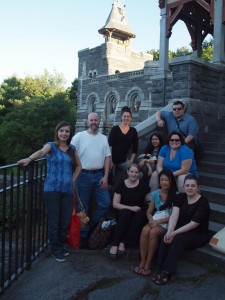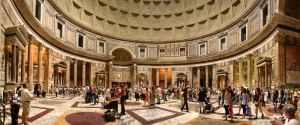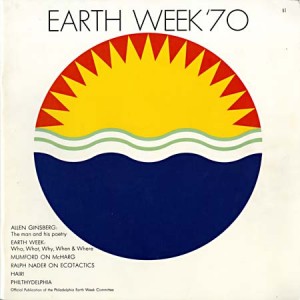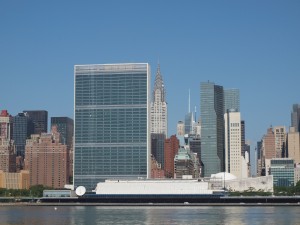
The first class of students in FIT’s MA in Sustainable Interior Environments learn about NYC’s modern water and sewage infrastructure during a tour of Central Park and the Belvedere Castle.
I just completed teaching a new course for a new program at FIT in New York City. My class, Survey of Sustainable Architecture and Interior Design Historical Origins, is the one required history/theory class in the Master of Arts in Sustainable Interior Environments. The program started last year and is two years long, including my summer course. For their final exam, I asked the students several questions to evaluate their understanding of the course themes as well as encourage them to inquire critically into the topic. I found their answers to question #1, engaging, thoughtful, provocative and delightful. An instructor couldn’t ask for anything more. Below are abstracts of some of their more insightful comments.
Question One: Is there a history of sustainable architecture and interior design?
Using examples of tradition, technology and urbanism, discuss why you believe that there IS or IS NOT a separate history of sustainable architecture. Is the history of sustainable architecture the SAME as the history of architectural design?
Alina believes there is a separate history and that science intertwines with art to prove it: There is a history of Sustainable Architecture, and a close connection between Sustainable Architecture, Sustainable Architectural Design, and our own connection with the entire grand planetary ecosystem. Sustainable Architecture should be first defined as both an art and a science…
Sustainable design is therefore founded on ecological thinking, involves science, imagination based on nature’s creations, even the Iroquois’ principle of “saving for the next seven generations”. Most of all, sustainable design involves the goal of changing lives, perceptions and expectations in a way that benefits the entire ecosystem, not only immediate human needs. Even if our personal “identity as a connection to the place is no longer determined by tradition” and is “increasingly related to imagability”, we must recreate the bridges demolished by our often brutal human interference with nature, and discontinue distancing ourselves from natural world.
Christine uses the industrial revolution to demonstrate how the two are separate: The history of sustainable architecture is not the same as the history of architectural design. The concept of sustainability is fairly new to architecture… Before the Industrial revolution, most architecture was eco-friendly and based on adaptations of local materials and climates to meet people’s needs…The Industrial Revolution in the 19th century increased due to the use of mechanical systems and lighting, which created immense expenditure of fossil fuels and the growth of greenhouse gas emissions.. Quoting Dean Hawkes from Cambridge, “There are many lessons for new design that may be learned from the “sustainable” building that pre-dates the industrial revolution.”

The durability and permanence of the Pantheon in Rome shows that sustainable architecture should be lasting. Photo courtesy Wikipedia.
Larry decided that our discussion on Rome’s Pantheon explained the history of sustainable architecture: Today sustainability is described by many as composed of a triple bottom line of social, economic and environmental considerations and defined by the ethic that any choice made today should not adversely impact future generations. The need for this thinking has emerged because of contemporary global ecological crisis, as well as growing international demand for social and economic justice. The Pantheon in Rome is an extreme example of a highly durable, sustainable building that features technological innovations, allowed for traditional practice and accommodates millions of visitors in an urban setting.
Was the Pantheon built using labor that was treated fairly? Who knows? Probably not. Was the Pantheon a sensible use of money in the time that it was built? Again, who would know the answer? How was the broader environment affected by the construction of Pantheon? What does seem clear is that the Pantheon has endured and serves millions of people that travel to experience it, or who use it as a church, or who read about it. For me, just looking at the floor – shows the bold checkerboard of circles and squares that could have been designed yesterday or tomorrow for a floor, a textile pattern, or a web page layout. It is at once very fresh and traditional.
Shannon reported: I had no clue that sustainability was more than just the Environment. It was Economy. It was people (Equity), too. I also had been asking myself since I began my Masters studies (I had yet to ask this question aloud) about where Preservation and Sustainability overlap, or where one stopped and the other began and where there may be conflict or support for one another. How surprised I was to begin to see that the Three Es were tied up in this as well! I am also happy to report that I feel there is a History of Sustainable Architecture and Design, not just a history of architecture and design, and that preservation is wrapped up into that and probably has taught us so much about how to approach things going forward. Preservation has opened up some dialogue, and while the answers are not totally there yet, that is okay because at least we are talking about it. And I am pleasantly surprised (and this thrills me because while there is a “modern” side to me, I am really at the heart of myself more of an “old soul”) to have found that history can be a model for sustainability going forward.

According to one student, Earth Day and Earth Week in 1970 may have signaled a divergence between the history of sustainable architecture and the history of architecture.
Elizabeth believes they are separate and that understanding history addresses why: In my readings and research, I think there is separate history of sustainable architecture/ interior design. One can argue that environmental or “ecological design” is an awareness that has been attained from the past and history to effectively address the issues at hand regarding the world and its environment. (Steele). The word sustainability was coined pretty recently in history in 1987. After the first “Earth Day” was held in 1970, people around the world began to take notice of the environment and how it has changed over time, as well as how many resources we have consumed since post industrialization.
Olesya countered the rest of her colleagues and proclaimed: Sustainable architecture is the same as the history of architecture. Architecture and ways of building along with sustainability are really one. The disconnection we are experiencing now is a cause of our own. But, looking back at history and the examples of architecture we can clearly see that these two are really one… Examples of the past remind us how structures were made and buildings were built in a way that kept these topics as one. Today we do see a separation but sustainability should really be good architecture and good interior design. People should always build with the occupant and environment along with the planet in mind.
Jessica sees them as integral but slightly diverging: The concepts of tradition, technology, and urbanism convey the history of sustainable architecture. Architecture developed and changed in response to cultural ideas and thoughts about how humans and society could and should function… A community of cultures has developed traditions on building. Technology has given us the ability to advance our traditions and expand our abilities, while seeing the impacts of our traditions. The urban environment has fostered the combination of our traditions and technology. Through the concepts of tradition, technology, and urbanism human beings have developed a growing understanding of how architecture impacts the environment. Examining these concepts throughout history helps illustrate and define the history of sustainable architecture.

Does the United Nations Headquarters’ focus on view but not orientation indicate a divergence between the history of architecture and the history of sustainable architecture?
And finally, Michael chose to use one of our iconic pieces of midcentury modern architecture to explain why the two are most certainly not the same:
One could argue that the history of sustainable architecture stretches back to our first dwellings, since many of the modern tenets of sustainability in the built environment have to do with things like using local materials in construction, minimizing energy use, considering orientation in relation to the sun, landscaping with native plants, and utilizing building methods favored in certain locales – all things that our oldest structures employed as a matter of course, since there were most likely few if any other options available. Back then, “sustainability” as we understand it today wasn’t a buzzword or catchphrase but the most immediate, effective, and economical way to erect a house, temple, school or just about any other building which was required at the time.
The United Nations Headquarters on the East River in Midtown Manhattan might be in the process of getting a “green” makeover to make it more sustainable, but this doesn’t disguise that fact that the building’s orientation makes it the constant victim of the sun. The fact that the UN building appears to have been situated in order to maximize views rather than conserve energy speaks volumes as to why our architectural and sustainable histories are simply not the same.
And if you’d like to “subscribe” or follow this blog, True Green Cities, please sign up through the “Subscribe” button at the bottom left of this page. You’ll receive a daily recap when new blogs are posted.
